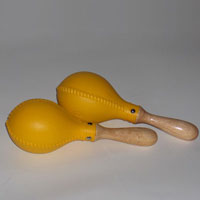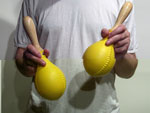
: : : Percussions : : Cuba : Instruments
The maracas

There are many types of maracas, which common feature is a sealed container in the shape of a rugby ball filled with grains (seeds). Some of them did not have a handle (original African calabash, or modern plastic, wood or silver "eggs"), but most of them have one and are played in pairs (one per hand). Maracas with handles are typical instruments of Amerindian, and it is almost the only instrument played by some tribes of the Amazon rainforest (the word "maraca" itself is Tupi, a language of Amazonian Brazilian tribes).
The Cuban maracas can be entirely of wood or have a seamed cowhide (invention of the Venezuelan "Pan con Queso" Landaeta), plastic or resin (more crystalline) receptacle.
The maracas are part of the "shakers" family (or "shaking" instruments like the Brazilian "ganza" ), but are obviously handled in a special way by the Cuban virtuosos.

They play them generally symmetrically (basic example: single stroke roll), a bit like drumsticks in single stroke rolls, the clashing of the grains back for a hand corresponding to the clashing of the grains forward with the other hand . You can also simply clash grains only down by bouncing (basic example: "chabada") (which allows you to make rests ad libitum or independent rhythms, polyrhythms), or make them run (roll, turn) along the wall (for a continuous sound). To do this you can put the handle up (like a bottle) or also down, in a vertical position.

The basic patterns involve a continuous single stroke roll with y accents and embellishments close to military drum (like doubling or triplet, for example). Many Cuban singers or backing vocalists play maracas while they sing.
Finally, specific techniques to double again the beats is to shift from a quarter the hands movement (alternate right hand forward, left hand back, right hand back, left hand forward, a bit like a binary shuffle with both hands, as the traditional technique of Brazilian "marcation" surdo ) or mimic a double stroke roll ("mommy-daddy": alternate right hand forward, right hand back, left hand forward, left hand back), or only double notes with one hand (independently).
Marc De Douvan, November 2005, translation in English: May 2013.
© 2005 Marc de Douvan Crédits Mentions légales
